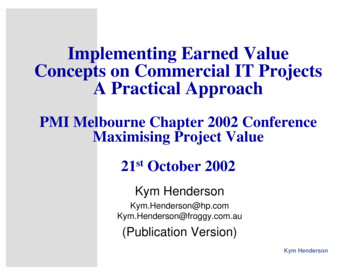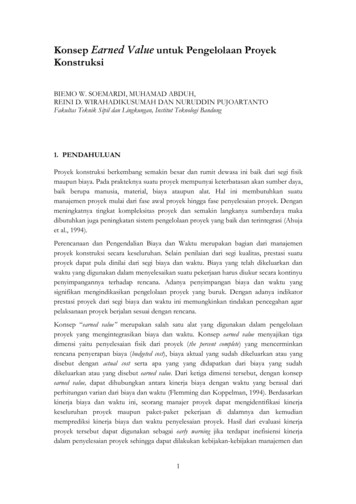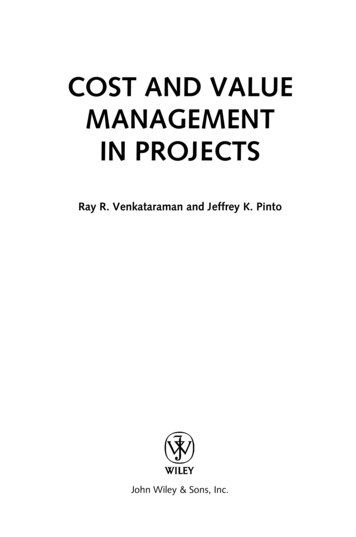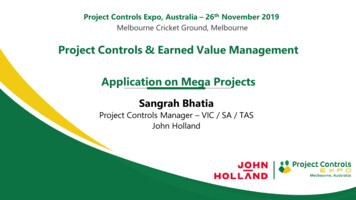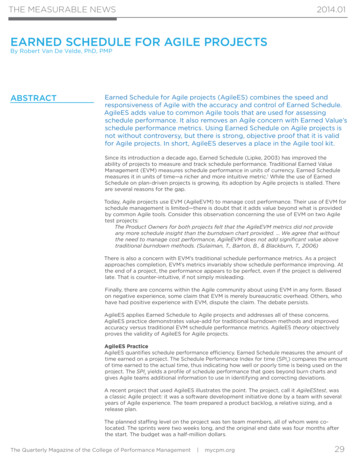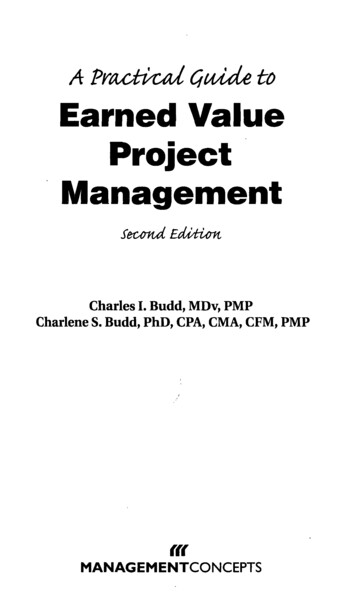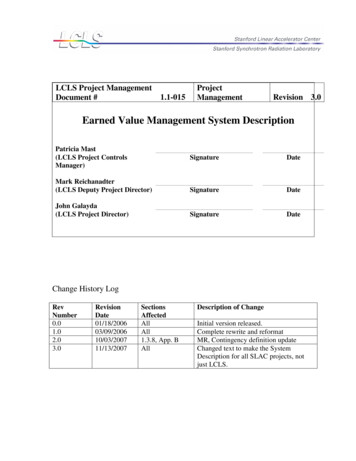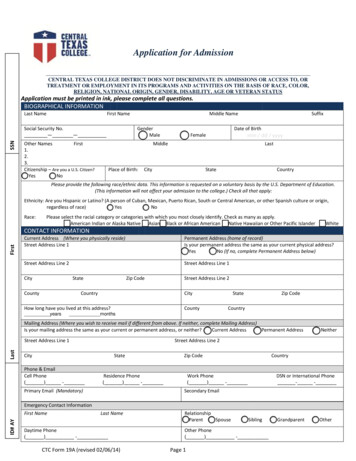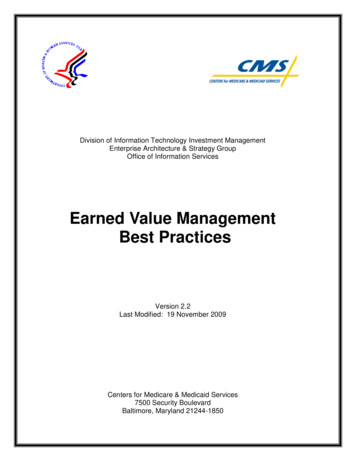
Transcription
Division of Information Technology Investment ManagementEnterprise Architecture & Strategy GroupOffice of Information ServicesEarned Value ManagementBest PracticesVersion 2.2Last Modified: 19 November 2009Centers for Medicare & Medicaid Services7500 Security BoulevardBaltimore, Maryland 21244-1850
Table of Contents1Purpose And Scope . 12Best Practices Appropriate For Individual CMS Projects . 22.1Define Strong Work Packages . 22.2Choose Measures Of Earned Value Wisely . 22.3Conduct Integrated Baseline Reviews . 22.4Control Changes To The PMB And Document Approved Changes . 22.5Provide Both Graphic And Numeric Depictions Of EVM Metrics. 32.6Analyze, Report On, And Act On Variances Monthly . 3Appendix A – Steps To Create An EVM Plan. 4Appendix B – Summary Of Measures Of Earned Value . 5Appendix C – Change Control: Revision To And Changes Of EVM Data . 8Appendix D – Glossary Of Terms . 11i
EVM Best Practices1 Introduction, Purpose, And ScopeEarned value management (EVM) is one of the tools in a project manager's toolbox. It is thefinancial look at what work was budgeted to be completed by now, what the budgeted costwas for the work that actually has been completed, and what the actual cost to date is. Itlooks at completion of authorized work and the authorized budget for that completed work,referred to as the "earned value."Since CMS manages approximately one fifth of the entire Federal budget, it is important thatwe use the taxpayers' dollars as efficiently and effectively as possible. CMS' portfolio ofinformation technology investments is developed and prioritized through our capitalplanning and investment control process, which involves senior management throughout theagency.Once an investment—with its individual projects—is approved for funding, it falls to theinvestment manager and the project managers to insure that the projects are implementedsuccessfully. Earned value monitoring and management provides early warning when aproject is straying from its baseline plan, and shows whether actions taken to correct thesituation are effective. HHS requires that certain investments track and report on cost andschedule status monthly.The purpose of this document is to present some ―best practices‖ for earned valuemanagement (EVM). It was originally drafted under contract HHSM-500-2006-00156G bya contractor to the Centers for Medicare & Medicaid Services (CMS) both fromobservations of other government agencies’ practice of EVM and from the contractor’sobservations of gaps in the robust application of EVM in both the public and private sectors.In the case of observed gaps and weaknesses, the contractor applied its EVM expertise toidentify means of closing the gaps and strengthening the practice of EVM.Because this document is intended for use by those who already have a working knowledgeof EVM, there is no attempt to explain EVM terminology that is commonly used amongpractitioners of EVM. A glossary is at Appendix D.The best practices documented here are those specific practices that should be applied bysome or all CMS investments and projects using EVM. Where the best practice might bevery simply described—but where the implementation might be non-trivial—an attachment,if available, is provided of a sample or draft document that can be the basis for teams’implementation of the practice. The reader will find depth on some best practices byreferring to the appendices.1
EVM Best Practices2 Best Practices Appropriate For Individual CMS ProjectsThe subsections that follow describe each best practice and reference any identified resourcesthat would be helpful to CMS teams in adopting the described best practice.2.1Define Strong Work PackagesThe single most important step that a project manager and control account manager can taketo develop and implement a meaningful EVM plan is to define ―strong‖ work packages.Strong work packages have the following characteristics:A clear definition of scope;A single responsible manager;A time-phased (say, monthly) budget;A discrete measure of earned value with a clear definition of completion;Accurate cost and performance tracking.2.2Choose Measures Of Earned Value WiselyAmong the most important characteristics of a strong work package is the method used tomeasure earned value. See Appendix B for guidance on this topic.2.3Conduct Integrated Baseline ReviewsThe integrated baseline review (IBR) is an excellent opportunity for the customer and otherstakeholders to achieve a mutual understanding with the contractor of important details ofthe project scope, risk management, schedule, and earned value management plan. IBRsshould be scheduled after project inception so that the project team has an opportunity toadequately plan the project. Depending on the complexity and planned duration of theproject and the prior experience of the contractor with the project work, the IBR might beheld from one to four months after contract award. Of all items to be reviewed at the IBR,the most important from an EVM perspective is the adequacy of work package definitions.See the discussions in subsection 2.1 above and Appendix A. See the IBR artifactelsewhere in the CMS Integrated IT Investment & System Life Cycle Framework.2.4Control Changes To The PMB And Document Approved ChangesProject managers should adopt a meaningful change control policy. The reality ofsignificant information technology projects is that requirements change, sometimes2
EVM Best Practicesmaterially. Appendix C, Change Control: Revision To And Changes Of EVM Data, is anexample EVM change control policy that the investment or project manager may adapt foruse.2.5Provide Both Graphic And Numeric Depictions Of EVM MetricsProject managers and other readers will all appreciate the creation of EVM reports thatdepict the metrics in both graphic and numeric form. Well-conceived graphic displays allowa quicker grasp of the underlying information. Additionally, graphic displays of timephased data facilitate the easy identification of trends. Trends are very meaningful in theanalysis of EVM metrics. Often, the recent trend is more important to understanding projectperformance than the absolute values of variances and other metrics.2.6Analyze, Report On, And Act On Variances MonthlyThe use of EVM is almost pointless if it is not used to actively manage the project. Projectmanagers should identify, analyze, and report on significant variances each month. Oncethe analysis is complete, the results should be used as the basis for any appropriatecorrective action. The corrective action should be documented and assessed after the fact todetermine if the anticipated outcomes were realized. Lessons learned over time will lead tostronger project management practices.3
Appendix A (Steps To Create An EVM Plan) to EVM Best PracticesAppendix A – Steps To Create An EVM PlanThe basic steps required to establish a strong EVM plan are summarized in Table 1: SummaryOf Steps In Creating An EVM Plan, below.Table 1: Summary Of Steps In Creating An EVM PlanWBS: Define all of the authorized work in a product-focused work breakdown structureWBS Dictionary: Define the meaning of and completion criteria for each WBS elementSchedule: Schedule all WBS elements, identifying the interdependencies in a critical pathnetworkOBS: Define the organizational structure in an organizational breakdown structureRAM: At the intersections of the OBS & WBS, define a responsibility assignment matrixCAs: In the RAM, identify control accounts for accountability in managing the assigned work;assign a single manager (CAM) to each control accountWPs: Group all WBS elements in each control account into one or more work packages; becertain that each WBS element is in a single WP; be certain that actual costs can be reasonablyisolated for each WPDocument the basis for each cost element and range of the cost estimatePPs: Establish planning packages for far-term effortTime-Phased Budget: Define a monthly budget (planned value) for each work package andplanning packageReflect the budget for each control account in the control account plans, in the RAM, and in thescheduleDefine objective measures of earning value for each work packageMinimize the use of the level-of-effort measure of earned valueMR/UB: Identify any management reserve and undistributed budgetAssure that all EVMS data can be appropriately identified and reconciled to the book of accountsAssure that all project costs are planned, including commercial items and materialAssure that the total project budget is equal to the sum of the control account budgets (includingsummary-level planning packages and undistributed budget) plus the management reserve4
Appendix B (Summary Of Measures Of Earned Value) to EVM Best PracticesAppendix B – Summary Of Measures Of Earned ValueOne of the most important choices that a control account manager (CAM) makes in establishingan EVM plan is to select an appropriate measure of earned value for each work package. Thischoice of the measure of interim progress, or completion, for each work package will do morethan any other discretionary choice in making the EVM results meaningful.There is no prescription for making the choice, nor is there a simple rule of thumb. Someguidance for making sound choices follows:1. Choose discrete, objective measures whenever it is reasonable to do so.2. If a work package is planned to be started and finished within a single reporting period(typically a calendar month), there is usually no better choice than the so-called 0/100measure.3. For longer work packages, choose one of the objective measures that will align the earning ofvalue closely to the corresponding point where costs are incurred. This will distort the resultsas little as possible during the time that the work has begun but has not yet been completed.4. If work packages have been made very granular and seem to lend themselves to 0/100, but atthe same time there may be too much of a burden tracking costs at that low level, considerrolling up the contemplated work packages into a longer duration work package for whichcost can be readily measured. Then treat the completion of the former work packages asweighted milestones within the longer work package.5. Avoid the use of Level of Effort (LOE) as much as possible so as to not distort the overallproject’s earned value. Use the Projected Cost Performance Index (PCPI) At Completionmethod in place of LOE, where there would otherwise be significant portions of the projectmeasured using LOE.The measures of earned value described below are listed in their rough order of preference andare grouped as discrete measures followed by more subjective measures.Discrete Measures of Earned ValueFixed Formula (X/Y Percent)o Take X% on Start / Take Y% on Finisho 0/100– 0% at beginning, 100% at end– simple, good for short duration work packages (WP)o Other X/Y Percents (25/75, 50/50, 40/60) – also simple; better if WP will span twomonths5
Appendix B (Summary Of Measures Of Earned Value) to EVM Best PracticesUnits Complete – good for longer WPs where multiples are being doneMilestone With Weighted Values – use for longer WPs with unequal milestonesMilestone Weights with Percent Complete –more subjectivityPercent Complete – satisfactory, if based on objective metricsApportioned Effort – for work that is not easily measured, but which is proportional to ameasurable effort. Avoid using an apportioned measure for a large value work packagewhere the basis for the apportioning is a significantly smaller value work package.More-subjective Measures Of Earned ValueProjected Cost Performance Index (PCPI) At Completion – better than LOE – computesearned value using a projected cost performance index (ratio of Budget At Completion(BAC) to current Estimate At Completion (EAC))Subjective Percent Complete – subjective assessment of progress (percent complete) is usedby the CAM to earn a cumulative percentage of the work package planned value equal to thedetermined percent complete.Level of Effort (LOE) – earned value planned value each periodo Use LOE as little as possible because it distorts the total project EVM metrics as theportion of the planned value derived from LOE work packages grows relative to thetotal project planned value;o LOE does not distinguish cost variance from schedule variance. All variance isrecognized as cost variance for LOE work packages.Advantages and Disadvantages of Selected Measures of Earned ValueThe table that follows outlines the advantages and disadvantages of many of the commonmeasures of earned value.6
Appendix B (Summary Of Measures Of Earned Value) to EVM Best PracticesAdvantages and Disadvantages of Selected Measures of Earned ValueEV MeasureAdvantagesDisadvantagesFixed FormulaWorks well for short term workpackages and requires minimal effort todetermine status.No significant disadvantages for shortterm, low value work packages. Notvery effective for longer term workpackages.MilestoneWeightingRequires objective, measurablemilestones, which most customer andproject managers prefer.Does not allow partial credit for inprocess work and requires detailedmilestone planning.MilestoneWeightingwith PercentCompleteRequires objective, measurablemilestones, which most customersprefer; allows for partial credit againstmilestone.Requires a Control Account Manager’sassessment of the percentage completefor each milestone and requiresdocumentation of the assessmentmethodology.Units CompleteAn objective and easy way ofdetermining the earned value for anactivity.Limited to production type atmosphereof similar items that are fixed unitprices. Does not take into considerationlabor fluctuations, so may misrepresentEV.SubjectivePercentCompleteThis is one of the more subjectivemethods, in which Earned Value isbased on the CAM’s assessment of thework package progress. Detailedplanning at the milestone level is notrequired.Customer satisfaction may be low due tothe subjectivity involved and the lack ofdetailed planning. However, CAMs arerequired to provide the customer withtheir assessment methodology.Level of EffortTrivial to implement and is appropriatefor sustaining tasks such as ProgramManagement.Offers no benefit over simple plannedvs. actual comparisons. The LOEmethod should be kept to a minimalportion of the project planned value toavoid distortion of the project levelmetrics.ApportionedEffortProvided a measure to ―unmeasurable‖work7Applying to a large-value work packagewhere the basis for the apportioning is asignificantly smaller value workpackage can distort measure.
Appendix C (Change Control) to EVM Best PracticesAppendix C – Change Control: Revision To, And ChangesOf, EVM DataThe establishment of an approved performance measurement baseline (PMB) and the tracking ofproject status represent only the beginning of project management control efforts. Variances,which must be addressed, will inevitably occur. Unanticipated changes to the baseline plan willalso occur. Such changes may affect the technical scope, schedule, and budget of the projectand, therefore, may require revisions to the baseline. If changes are not documented andcontrolled, the project being measured may turn out to be something other than the project thatwas intended. A firm basis for project control can only be assured when the approved baselineincorporates changes timely as they occur.The ANSI /EIA-748-B-2007 Earned Value Management Systems standard recognizes five typesof changes to EVM data. These changes are: retroactive changes, authorized changes, internalre-planning, operating schedule/plans changes, and over-target baselines (OTB)Retroactive ChangesRoutine accounting adjustments and the correction of data errors must be permitted in allmanagement information systems. However, that same management information system mustprevent inappropriate changes to the PMB. Each project must control retroactive changes torecords of work performed that would change the previously recorded amounts for actual costs,earned value, or budgets. This control effort is necessary to ensure baseline integrity and theaccuracy of performance measurement data. All retroactive changes to EVM data must berecorded in the Budget Baseline Log or some equivalent.Authorized ChangesThe work scope for authorized changes to the PMB should be entered in a documented,disciplined, and timely manner. By adhering to this guideline the project can increase theprobability that budget, schedule, and work remain consistent. In those instances where changeorders are un-priced, the contractor will develop its best estimate for planning and budgetingpurposes for incorporation into the PMB. The incorporation of changes into the PMB will noteliminate existing cost and schedule variances when no work packages are closed or other PMBadjustments are authorized. Each authorized change must be documented in a change control log(at a minimum in the Budget Baseline Log). The reader is requested to read the section belowtitled ―Change Control to Open Work Packages‖ to gain additional insight into the re-planning ofwork in progress.8
Appendix C (Change Control) to EVM Best PracticesInternal Re-planningMaking adjustments to the PMB that involve the re-planning of future time-phased effort is anormal management process that needs to be done as things happen and situations change. Inperforming internal re-planning it is important that overall project scope, cost, and scheduleobjectives are supported. It is also important that retroactive changes be controlled.Management Reserve (MR) may be employed where there is future work beyond the scope ofopen work packages and re-planning actions cannot be handled within existing budgets andschedule constraints of the control accounts. The reader is again requested to read the sectionbelow titled ―Change Control to Open Work Packages‖ to gain additional insight into the replanning of work in progress.Operating/Schedule Plan ChangesUnder normal operating circumstances a performing organization’s operating plan and the PMBare one and the same. Occasions may arise when a project finds it advantageous to have aninternal recovery plan that differs from the PMB. This recovery plan should not replace thePMB as the basis for performance measurement.Over-Target BaselineOver Target Baseline (OTB) is a term used, normally on a government contract, to describe asituation where the budget or schedule in the performance measurement baseline exceeds theproject targets. An OTB may be applied by a contractor when it is determined that currentprogram conditions do not permit the performing organizations to have realistic plans forcompleting the program on schedule. Any revision to the PMB must be authorized by thecustomer (government).Change Control For Open Work PackagesWhen changes are made to the budget of open work packages (WP), they may cloud theinterpretation of performance (BCWP) earned to date. To avoid losing the historicalperformance of the WPs, any WP impacted by such a change should be closed, and a new,revised WP opened. The cumulative budget (Cumulative BCWS) of any impacted work packageshould be made equal to the earned value (Cumulative BCWP). This step effectively eliminatesany schedule variance that existed at the time of the change. This step is seen as logical since theschedule must be reevaluated as a result of the change.On the other hand the actual cost (ACWP) is maintained at its true value. Any cost variancemust be maintained to provide a basis for accurate forecasts of future costs.The remaining budget or Budgeted Cost of Work Remaining (BCWR BCWP - BAC for theoriginal work packages) for each work package should be returned to Undistributed Budget(UB). UB is budget included in the Performance Measurement Baseline (PMB) but which hasnot yet been allocated to a Control Account (CA). The new WPs that are created during thisexercise will draw from this UB when they are developed.9
Appendix C (Change Control) to EVM Best PracticesAgency Monitoring Of EVM Reporting And ChangesCMS receives all EVM reports monthly and monitors them for conformance to the agency EVMpolicies and procedures. This review serves as a mechanism (in addition to ongoingmanagement review) to prevent unauthorized changes.ConclusionChange is a fact of life for any project. Since changes are inevitable, a change controlmechanism is needed. Although changes are seen as necessary, steps must be taken to minimizethem and to keep the change control process disciplined. All efforts made in this area of changecontrol will assist in the maintenance of the integrity of the PMB.All changes to the PMB must be identified with respect to their specific control account andwork package identity as well as their schedule identity. Since the control account represents thecontrol level for project efforts, the control account schedule, scope, and budgets must beformally adjusted in accordance with any change control documentation. In those cases wherethe control account is already open, this adjustment may be accomplished by closing the accountand opening a new account, which picks up the remaining scope as well as any additional scopeidentified in the change. Changes to schedule, scope, and budget may be made to futureelements of open work packages within control accounts without closing the work package orcontrol accounts.10
Appendix D (Glossary Of Terms) to EVM Best PracticesAppendix D – Glossary Of TermsThe notational style used in this glossary is to begin the definition of each defined termwith a new paragraph beginning with the term in UPPERCASE. Any word or phraseused in a definition may appear in UPPERCASE ITALICS to call attention to the fact thata definition of the word or phrase is included elsewhere in the glossary.ACTUAL COST (AC or ACWP) – The costs actually incurred and recorded in accomplishingthe work performed within a given time period. Also known as the ACTUAL COST OF WORKPERFORMED.ACTUAL COST OF WORK PERFORMED (ACWP or AC) – See ACTUAL COST.AUTHORIZED WORK – Effort (scope of work) on a contract or assigned by management;work that is within the scope of the applicable statement of work or contract.BUDGET AT COMPLETION (BAC) – The total budget planned to accomplish the workdefined for a work package or project. For a project, the BAC includes any UNDISTRIBUTEDBUDGET but does not include any MANAGEMENT RESERVE.BUDGETED COST OF WORK PERFORMED (BCWP) – A measure of the work completedexpressed as the planned cost or budgeted amount the work was supposed to have cost. As anexample, if an activity were planned to have cost ten dollars, when the activity is complete, weattribute to the activity a BUDGETED COST OF WORK COMPLETED amount equal to tendollars. The BCWP is also known as ―EARNED VALUE.‖BUDGETED COST OF WORK REMAINING (BCWR) – The difference between the BUDGETAT COMPLETION and the cumulative EARNED VALUE for a project or WORK PACKAGE.(More informally, it is the PLANNED VALUE that remains to be earned while completing theproject or the WORK PACKAGE.) This value must be computed to properly close an incompleteWORK PACKAGE.BUDGETED COST OF WORK SCHEDULED (BCWS) – For a project, the sum of the budgetsfor all WORK PACKAGES and PLANNING PACKAGES scheduled to be accomplished(including in-process and completed WORK PACKAGES), plus the amount of LEVEL OFEFFORT and APPORTIONED effort scheduled to be accomplished within a given time period.For a WORK PACKAGE or PLANNING PACKAGE, the BCWS is the budgeted amount for thepackage. The BCWS is also referred to as the PLANNED VALUE (PV).CONTRACT PERFORMANCE PEPORT (CPR) - a common format for reporting performanceinformation; originated as a DoD form (DD Form 2734/1 through 2734/5).CONTRACT WORK BREAKDOWN STRUCTURE (CWBS) – A portion of the WORKBREAKDOWN STRUCTURE for the project developed and maintained by a seller contracting toprovide a subproject or a project component.11
Appendix D (Glossary Of Terms) to EVM Best PracticesCONTRACTING OFFICER (CO) - A Federal government employee who has been delegatedthe authority to enter into, modify, administer, and/or terminate contracts.CONTRACTING OFFICER’S TECHNICAL REPRESENTATIVE (COTR) - A Federalemployee to whom a CO has delegated limited authority in writing to make specified contractrelated decisions, usually related to the technical requirements of the SOW.CONTROL ACCOUNT (CA) – A management control entity (aggregation of work to bemanaged) at which budgets (resource plans) and actual costs are accumulated and compared toEARNED VALUE for management control purposes. A CONTROL ACCOUNT is a naturalmanagement point for planning and control since it represents the work assigned to oneresponsible organizational element for one program work breakdown structure element. Acontrol account is managed by a CONTROL ACCOUNT MANAGER (CAM). A CONTROLACCOUNT may contain multiple WORK PACKAGES, PLANNING PACKAGES, and CONTROLACCOUNTS.CONTROL ACCOUNT MANAGER (CAM) – The manager responsible for management of aCONTROL ACCOUNT.CONTROL ACCOUNT PLAN (CAP) – A consolidated, time-phased budget for accomplishingall of the work defined in the scope of the CONTROL ACCOUNT, including the measures ofEARNED VALUE to be used for each WORK PACKAGE as well as the budgets for those WORKPACKAGES, any PLANNING PACKAGES, and any lower level CONTROL ACCOUNTS.COST ACCOUNT – An outdated name for a CONTROL ACCOUNT.COST PERFORMANCE INDEX (CPI) – An indicator of the cost efficiency of the workaccomplished for a specific period of time as derived by the formula: CPI BCWP / ACWP,e.g., EARNED VALUE divided by ACTUAL COST.COST PERFORMANCE REPORT (CPR) – A report defined by the Department of Defense alsoused by other organizations for reporting EVM results. Five specific forms of report are defined,known as Format 1 through Format 5.COST/SCHEDULE STATUS REPORT (C/SSR) – A performance measurement reportestablished for reporting on smaller contracts not subject to reporting full, ANSI/EIA 748-AStandard for Earned Value Management System results.COST VARIANCE (CV) – A measure of project (or work package) performance relative to theproject’s (or WORK PACKAGE’S) budget baseline. It is the difference between EARNEDVALUE and ACTUAL COST (COST VARIANCE EARNED VALUE - ACTUAL COST.) Apositive value indicates a favorable condition and a negative value indicates an unfavorablecondition.CRITICAL PATH – The path through a network of dependant tasks within a project resulting inthe longest elapsed time from the start of the first task to the completion of the last task such thatthis path determines the shortest possible duration of the project. Any delay in the completion ofa single task in this CRITICAL PATH would result in the same delay in completion of theproject. CRITICAL PATH analysis is the action required to determine the CRITICAL PATH or12
Appendix D (Glossary Of Terms) to EVM Best Practicespaths. The CRITICAL PATH method is the management discipline of performing CRITICALPATH analysis.DHHS - U.S. Department of Health & Human Services; the Centers for Medicare & MedicaidServices is an operating division (OPDIV) of DHHS.DID - Data item description; explains what data is to be entered into each field of a blank form;the CPR DID is DI-MGMT-81466A.DIRECT COST - Costs attributable to a single WORK PACKAGE.DME - Development, maintenance, and enhancement; a category of investment; see STEADYSTATE.DoD - U.S. Department of Defense.EARNED VALUE (EV or BCWP) – A measure of completed work that is equal to the budgetplanned for that work. See also ―BUDGETED COST OF WORK PERFORMED.‖EARNED VALUE MANAGEMENT SYSTEM (EVMS) – A management control system thatintegrates the work scope of a program with the schedule and cost elements for optimumprogram planning and control, unlike a simple planned cost vs. actual cost comparison. A keycharacteristic of an EVMS is that work accomplished is measured in terms of the cost budgetedfor that work. In Federal government contractual terms, an EVMS must conform to theguidelines for such systems defined in ANSI/EIA 748 Standard, Earned Value ManagementSystems.ESTIMATE AT COMPLETION (EAC) – The current expected cost of the project. The EAC isordinarily computed as the ACTUAL COST to-date plus the current ESTIMATE TO COMPLETE.At project inception, the EAC should be identical to the BAC. As project work is accomplished,it is very likely that the EAC will vary from the BAC.ESTIMATE TO COMPLETE (ETC) – The current anticipated remaining cost of the project.There are frequently multiple ESTIMATES TO COMPLETE at any point in time. One or moremay be developed by the project manager or CONTROL ACCOUNT MANAGER using anyreasonable estimating technique. Other estimates may be computed using formulaeincorporating cost and schedule trends realized to-date. These formula-based estimates arefrequently referred to as ―independent estimates.‖EXECUTIVE STEERING COMMITTEE (ESC) - Each CMS ESC reviews all IT investments inits functional areas from an enterprise perspective, prioritize IT investment requests usingscoring criteria approved by the ITIRB, and prepare recommendations for the ITIRB.FEDERAL ACQUISITION REGULATION (FAR) - Title 48 U.S.C.; The FAR is the primaryregulation used by Federal agencies in acquisition of supplies and services. It is issued by theGeneral Services Administration, the DoD, and the National Aeronau
A discrete measure of earned value with a clear definition of completion; Accurate cost and performance tracking. 2.2 . Choose Measures Of Earned Value Wisely . Among the most important characteristics of a strong work package is the method used to measure earned value. See Appendix B for guidance on this topic. 2.3 . Conduct Integrated .
